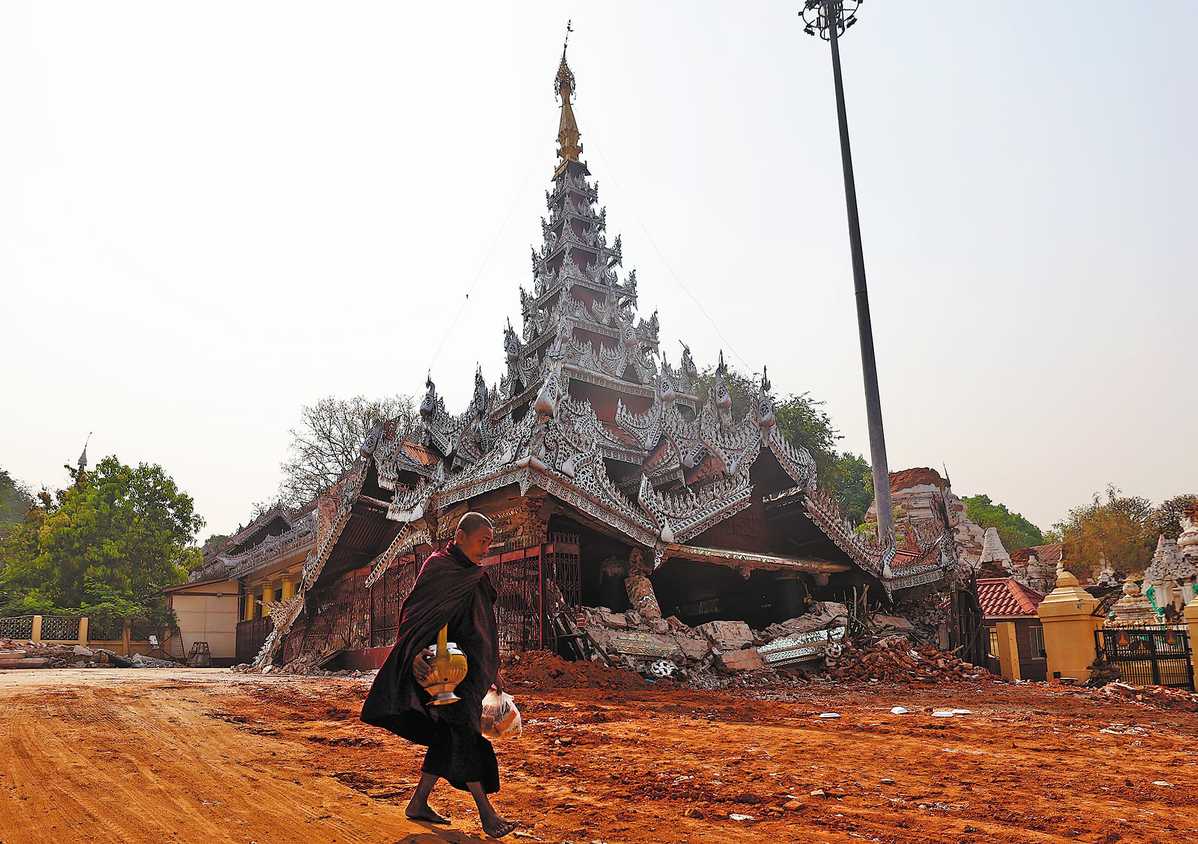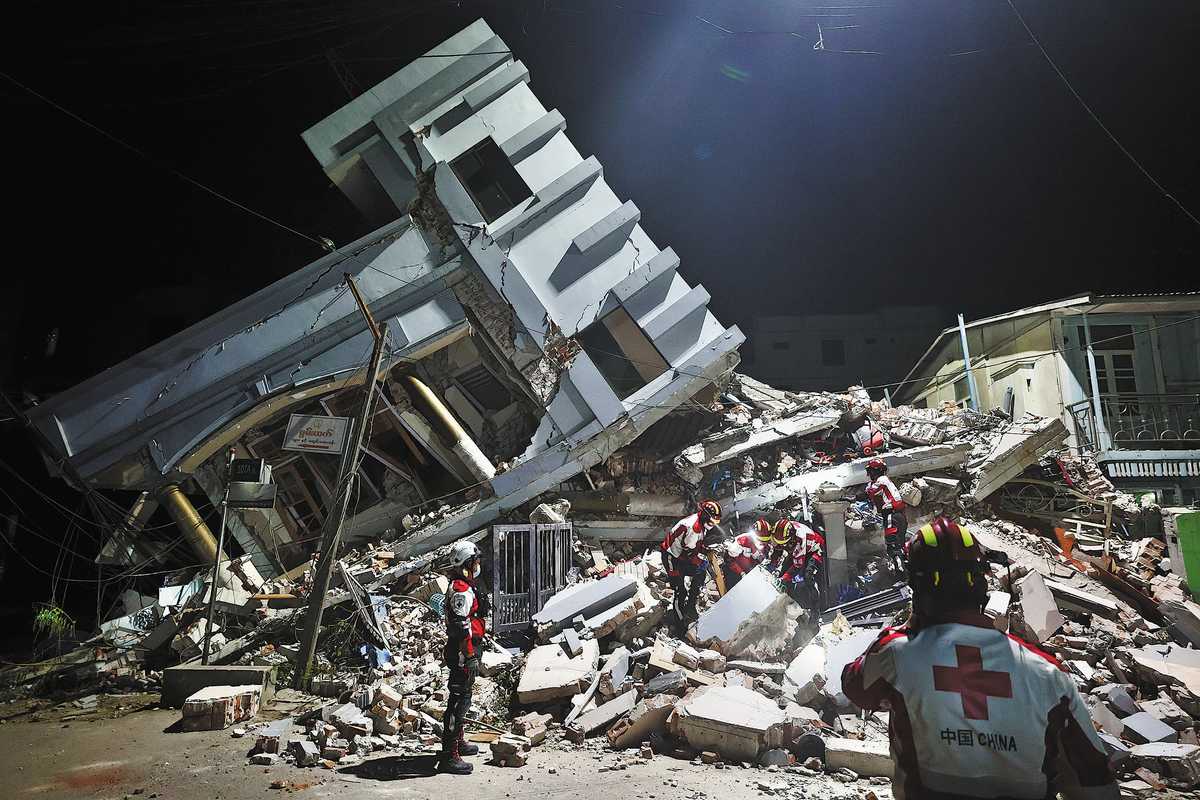
A monk passes by a destroyed temple in Mandalay, Myanmar, on Tuesday. PHOTO BY WEI XIAOHAO/CHINA DAILY
Editor's note: In this weekly feature China Daily gives voice to Asia and its people. The stories presented come mainly from the Asia News Network (ANN), of which China Daily is among its 20 leading titles.
Aid groups in the worst-hit areas of Myanmar said there was an urgent need for shelter, food and water after an earthquake that killed more than 2,800 people as of Tuesday.
The death toll is expected to rise to more than 3,000, Myanmar's military leader Min Aung Hlaing said in a televised address on Tuesday. He said 4,521 people were injured, and 441 were missing.
The 7.7 magnitude quake, which hit around lunchtime on Friday, was the strongest to hit the Southeast Asian country in more than a century, toppling ancient pagodas and modern buildings alike.
"In the hardest-hit areas … communities struggle to meet their basic needs, such as access to clean water and sanitation, while emergency teams work tirelessly to locate survivors and provide lifesaving aid," the United Nations Office for the Coordination of Humanitarian Affairs said.
Drinking water, hygiene, food, shelter and medicine are the most critical needs following extensive damage to buildings, roads and bridges, said Marcoluigi Corsi, acting humanitarian and resident coordinator of the UN following a two-day visit.
"Having lived through the terror of the earthquake, people now fear aftershocks and are sleeping outside on roads or in open fields," a worker from the International Committee of the Red Cross in Mandalay said in a report.

Chinese Red Cross International Emergency Response Team carried out searching and rescuing work in Mandalay, Myanmar, on Monday. PHOTO BY WEI XIAOHAO/CHINA DAILY
"We remain, of course, deeply committed to reaching people in Myanmar who need aid," UN spokesperson Stephane Dujarric said. "And we must act swiftly to provide relief before the upcoming monsoon season, which, of course, will even worsen this horrendous crisis."
Huge impact
Scientists emphasized the seismic event's significant force and the factors contributing to its impact.
US geologist Jess Phoenix described the earthquake's energy release as equivalent to 334 atomic bombs, warning that aftershocks will continue to pose a significant threat for months.
She highlighted the ongoing collision of the Indian and Eurasian tectonic plates as a continuing source of seismic activity.
The Science Media Centre in the United Kingdom has compiled expert commentary, revealing a consensus on the earthquake's destructive potential.
Ian Watkinson, scholar from Royal Holloway, University of London, echoed these concerns, noting the earthquake's likely propagation along the Sagaing Fault, potentially up to 200 kilometers.
He highlighted the vulnerability of Mandalay and other regional cities, which have experienced rapid high-rise concrete construction, often on the floodplains of the Irrawaddy River.
Giving aid
Rescue workers, sniffer dogs, paramedics and millions of dollars in aid have begun arriving in Myanmar after a massive earthquake ravaged much of the country.
China has announced $14 million in assistance for Myanmar, including 1,200 tents, 8,000 blankets and 40,000 first aid kits.
Chinese teams that arrived 18 hours after the quake and more than 400 Chinese personnel are now on the ground in the region.

Residents line up for dinner at a shelter for disaster victims in Mandalay, Myanmar, on Monday. PHOTO BY WEI XIAOHAO/CHINA DAILY
China also has multiple teams in Thailand, according to Xinhua News Agency.
According to the China International Development Cooperation Agency, the initial supplies included tents, blankets and first aid kits.
The United States pledged $2 million in aid "through Myanmar-based humanitarian assistance organizations".
It said in a statement that an emergency response team from USAID, which is undergoing massive cuts under the US administration, is being sent to Myanmar.
Two Russian aircraft carrying 60 rescue workers, four dogs, ambulances and rescue vehicles arrived in Myanmar's capital Nay Pyi Taw on Sunday, Myanmar's state broadcaster MRTV reported.
The Japanese government has dispatched a five-person assessment party that includes medical professionals to lay the groundwork for a larger emergency rescue team.
India sent a search and rescue team, medical professionals and a military transport aircraft filled with blankets, hygiene kits, food packets and other essential items on Saturday.
Vietnam has sent a team of more than 100 rescuers, medical staff and firefighters along with aid and sniffer dogs.
Thailand, which was also hit by the quake, has sent 55 air force personnel, including medics and search and rescue specialists, as well as medical supplies to Myanmar.
Indonesia's military said in a statement on Monday that it was sending emergency teams, including search and rescue workers, to Myanmar, as well as tents, food and logistical supplies.
Singapore has sent an 80-member team to assist with disaster rescue efforts. The government contributed about $112,000 as seed money to support the fundraising efforts of the Singapore Red Cross.
Agencies via Xinhua